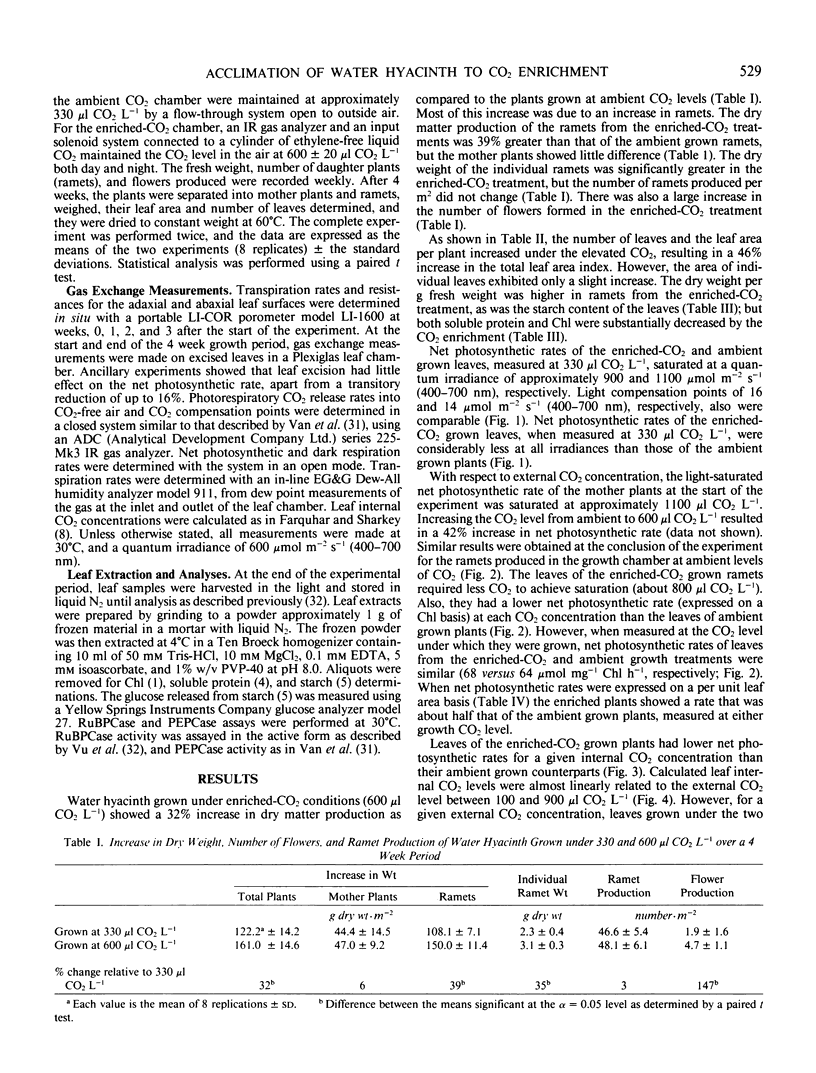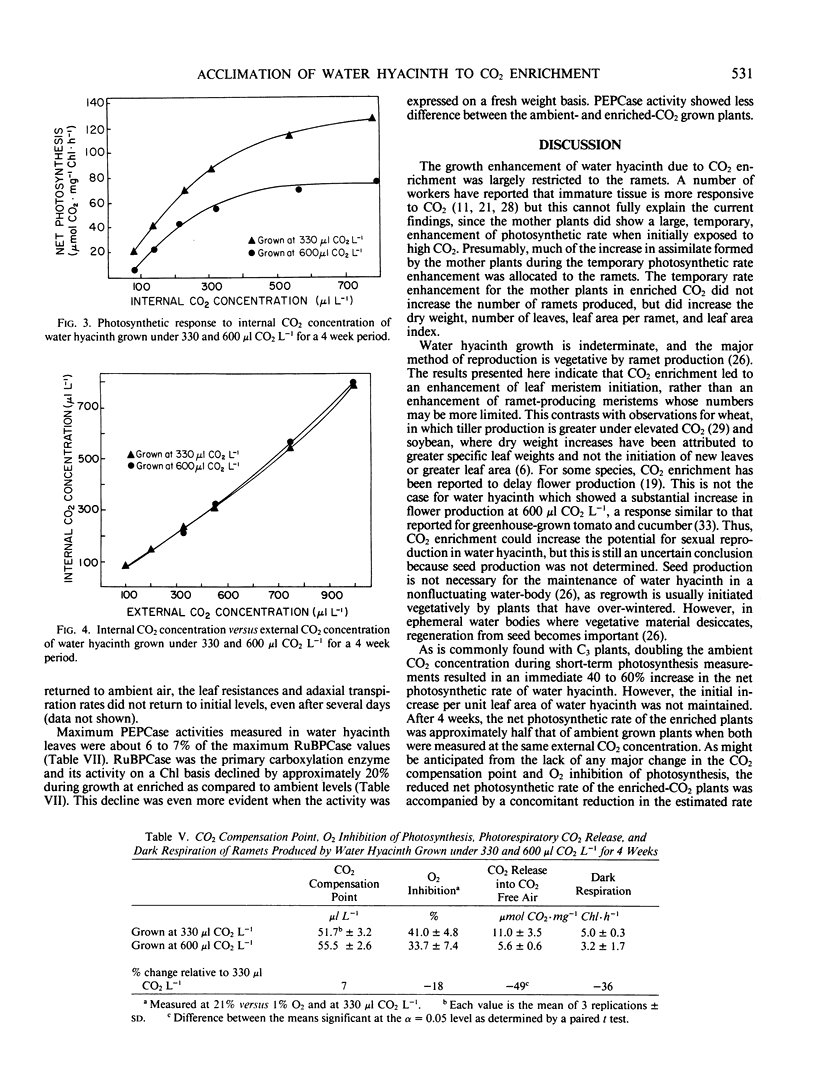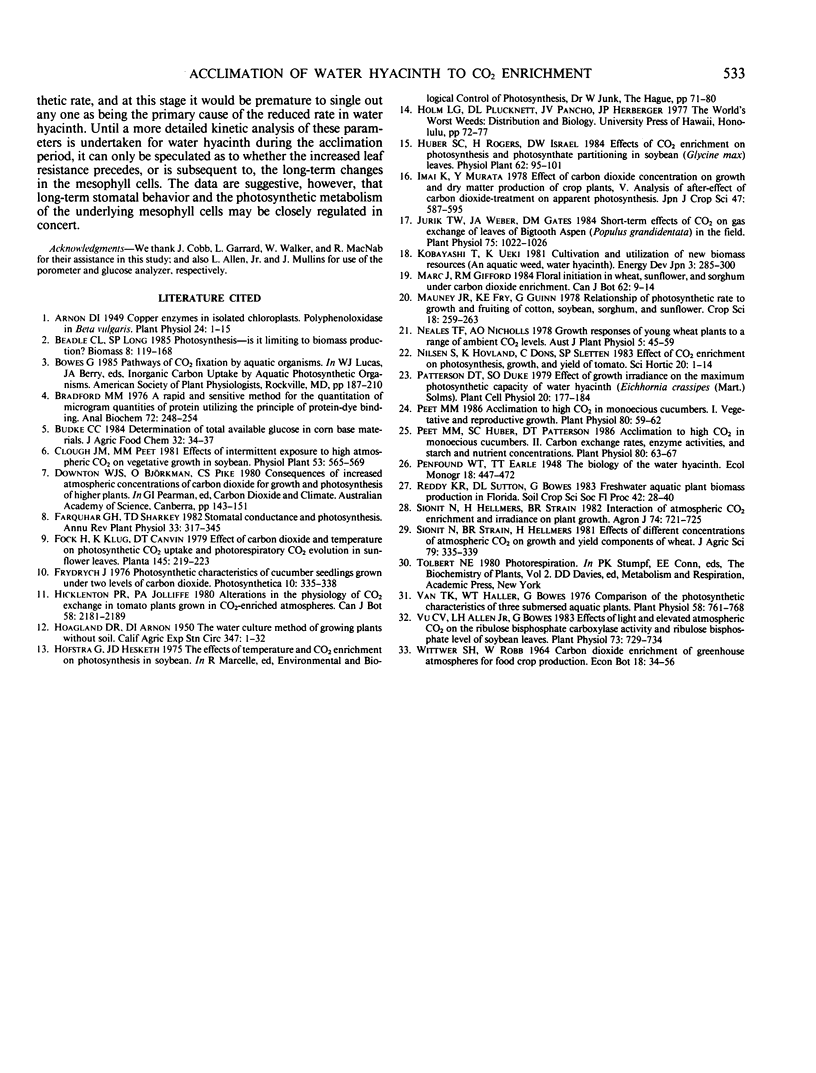Abstract
Water hyacinth (Eichhornia crassipes [Mart.] Solms) plants were grown in environmental chambers at ambient and enriched CO2 levels (330 and 600 microliters CO2 per liter). Daughter plants (ramets) produced in the enriched CO2 gained 39% greater dry weight than those at ambient CO2, but the original mother plants did not. The CO2 enrichment increased the number of leaves per ramet and leaf area index, but did not significantly increase leaf size or the number of ramets formed. Flower production was increased 147%. The elevated CO2 increased the net photosynthetic rate of the mother plants by 40%, but this was not maintained as the plants acclimated to the higher CO2 level. After 14 days at the elevated CO2, leaf resistance increased and transpiration decreased, especially from the adaxial leaf surface. After 4 weeks in elevated as compared to ambient CO2, ribulose bisphosphate carboxylase activity was 40% less, soluble protein content 49% less, and chlorophyll content 26% less; whereas starch content was 40% greater. Although at a given CO2 level the enriched CO2 plants had only half the net photosynthetic rate of their counterparts grown at ambient CO2, they showed similar internal CO2 concentrations. This suggested that the decreased supply of CO2 to the mesophyll, as a result of the increased stomatal resistance, was counterbalanced by a decreased utilization of CO2. Photorespiration and dark respiration were lower, such that the CO2 compensation point was not altered. The photosynthetic light and CO2 saturation points were not greatly changed, nor was the O2 inhibition of photosynthesis (measured at 330 microliters CO2 per liter). It appears that with CO2 enrichment the temporary increase in net photosynthesis produced larger ramets. After acclimation, the greater total ramet leaf area more than compensated for the lower net photosynthetic rate on a unit leaf area basis, and resulted in a sustained improvement in dry weight gain.
Full text
PDF





Selected References
These references are in PubMed. This may not be the complete list of references from this article.
- Arnon D. I. COPPER ENZYMES IN ISOLATED CHLOROPLASTS. POLYPHENOLOXIDASE IN BETA VULGARIS. Plant Physiol. 1949 Jan;24(1):1–15. doi: 10.1104/pp.24.1.1. [DOI] [PMC free article] [PubMed] [Google Scholar]
- Bradford M. M. A rapid and sensitive method for the quantitation of microgram quantities of protein utilizing the principle of protein-dye binding. Anal Biochem. 1976 May 7;72:248–254. doi: 10.1006/abio.1976.9999. [DOI] [PubMed] [Google Scholar]
- Jurik T. W., Weber J. A., Gates D. M. Short-Term Effects of CO(2) on Gas Exchange of Leaves of Bigtooth Aspen (Populus grandidentata) in the Field. Plant Physiol. 1984 Aug;75(4):1022–1026. doi: 10.1104/pp.75.4.1022. [DOI] [PMC free article] [PubMed] [Google Scholar]
- Peet M. M. Acclimation to High CO(2) in Monoecious Cucumbers : I. Vegetative and Reproductive Growth. Plant Physiol. 1986 Jan;80(1):59–62. doi: 10.1104/pp.80.1.59. [DOI] [PMC free article] [PubMed] [Google Scholar]
- Peet M. M., Huber S. C., Patterson D. T. Acclimation to High CO(2) in Monoecious Cucumbers : II. Carbon Exchange Rates, Enzyme Activities, and Starch and Nutrient Concentrations. Plant Physiol. 1986 Jan;80(1):63–67. doi: 10.1104/pp.80.1.63. [DOI] [PMC free article] [PubMed] [Google Scholar]
- Van T. K., Haller W. T., Bowes G. Comparison of the photosynthetic characteristics of three submersed aquatic plants. Plant Physiol. 1976 Dec;58(6):761–768. doi: 10.1104/pp.58.6.761. [DOI] [PMC free article] [PubMed] [Google Scholar]
- Vu C. V., Allen L. H., Bowes G. Effects of Light and Elevated Atmospheric CO(2) on the Ribulose Bisphosphate Carboxylase Activity and Ribulose Bisphosphate Level of Soybean Leaves. Plant Physiol. 1983 Nov;73(3):729–734. doi: 10.1104/pp.73.3.729. [DOI] [PMC free article] [PubMed] [Google Scholar]


